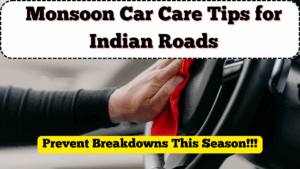As the rainy season sweeps across India, it brings much-needed relief from summer heat—but also creates havoc for unprepared vehicles. From slippery roads and water-logged streets to rust, engine troubles, and brake failures, the monsoon months can be harsh on your car. With 2025 monsoons expected to be intense in several regions, prioritizing rainy season maintenance is not just about convenience—it’s about safety.
Monsoon driving requires more than just caution behind the wheel. Your car should be mechanically and electrically ready to face everything the Indian roads throw at it. This guide covers everything you need to do to keep your vehicle in top shape this season.

Why Monsoon Maintenance Is Essential in 2025
Unlike western nations, Indian roads often lack proper drainage, leading to flooded roads and pothole-ridden streets. Here’s why rainy season maintenance must be taken seriously:
-
Water damage to engine and electronics can cost thousands in repairs.
-
Rust formation is faster in humid, wet conditions, especially undercarriage and wheel wells.
-
Brakes become less responsive due to water accumulation.
-
Visibility issues due to wipers and fogged-up windshields create dangerous situations.
Being proactive with monsoon driving preparation helps you prevent breakdowns and ensure your car performs well despite poor road and weather conditions.
Must-Do Vehicle Tips for Monsoon Season
Here’s a list of essential vehicle tips every Indian car owner should follow during the monsoon months:
-
Check Tyres and Tread Depth: Replace worn-out tyres; they lose grip on wet roads. Make sure tread depth is above 2mm for proper water dispersion.
-
Inspect and Replace Wiper Blades: Streaky wipers are a danger. Replace them annually or at the first sign of smudging.
-
Clean AC Vents and Cabin Filter: Moist air can create foggy interiors and unpleasant odors. Get your AC serviced for clear ventilation.
-
Apply Anti-Rust Coating: Pay special attention to underbody and door panels. Regular washing also helps remove road salts and grime.
-
Test Brakes Regularly: Water can reduce brake efficiency. Make sure pads, discs, and brake fluids are in good condition.
-
Seal Electrical Points: Ensure the battery, fuse box, and wiring connections are insulated and water-proofed.
By following these simple steps, you enhance both performance and India auto safety standards during this tricky season.
Avoid These Common Mistakes During Monsoons
Many drivers unintentionally harm their vehicles during the rainy season by ignoring basic care. Watch out for:
-
Driving through deep water without knowing the depth—this can lead to hydrostatic lock and engine failure.
-
Parking under trees—increases chances of leaf clogging and paint damage.
-
Not using headlights in low visibility—puts your safety and that of others at risk.
-
Skipping underbody wash after rain exposure—leads to long-term corrosion.
A bit of rainy season maintenance today can save you from big repair bills tomorrow.
Quick Checklist: Monsoon-Ready Car
| Car Component | What to Do | Why It’s Important |
|---|---|---|
| Tyres & Tread | Ensure good grip, replace if worn | Prevents skidding on wet roads |
| Wipers & Washers | Clean or replace blades and fill washer | Clear vision during rains |
| Headlights & Indicators | Check bulbs, alignment, and fog lamps | Essential for low-visibility driving |
| Brakes | Service brake pads and clean discs | Reliable stopping power in wet |
| Underbody Protection | Apply anti-rust coating and wash regularly | Stops rust and corrosion |
| Battery Terminals | Clean and seal from moisture | Prevents short circuits |
With this checklist, your car will be fully ready for the harshest of monsoon driving conditions in India.
Extra Safety Tips for Monsoon Commuters
-
Drive slower and maintain more distance from the vehicle ahead.
-
Use fog lamps when visibility drops but avoid high beams during rains.
-
Keep a microfiber cloth handy to defog interiors.
-
Avoid sudden braking and sharp turns on wet surfaces.
-
Carry an emergency kit including tow rope, flashlight, umbrella, and phone charger.
Taking these extra measures will ensure you not only avoid breakdowns but also protect your passengers and others on the road.
FAQs
How often should I wash my car during monsoon?
It’s ideal to wash your car once a week during monsoon to remove mud, salts, and prevent rust—especially under the car body.
Is tyre pressure important during rains?
Yes, keep tyres properly inflated. Low pressure reduces road grip while high pressure can reduce traction on wet roads.
What is hydrostatic lock and how can I prevent it?
Hydrostatic lock occurs when water enters the engine through the air intake. Avoid driving through deep water and never restart a stalled car in a flooded area.
Do I need anti-rust treatment every year?
If you live in a humid or coastal area, yes. An annual anti-rust treatment is recommended to preserve your vehicle’s India auto lifespan.
Are fog lights necessary during Indian monsoons?
Yes, especially in states with heavy rainfall and poor visibility. Use them with low beams, not high beams, for better road visibility.
Click here to know more.
